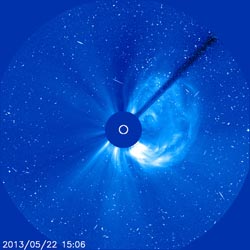NASA's SDO Observes Mid-level Solar Flare

This image, captured at 11:06 a.m. EDT on May 22, 2013, from the ESA/NASA Solar and Heliospheric Observatory shows theconjunction of two coronal mass ejections streaming away from the sun. This image is what's known as a coronagraph, in which the light of the sun is blocked in order to make its dimmer atmosphere, the corona, visible. Credit: ESA and NASA/SOHO <br>
While this CME was not Earth-directed, it has combined with an earlier CME, and the flank of the combined cloud may pass Earth. Particles from the CME cannot travel through the atmosphere to harm humans on Earth, but they can affect electronic systems in satellites and on the ground.
Experimental NASA research models, based on observations from NASA’s Solar Terrestrial Relations Observatory and ESA/NASA’s Solar and Heliospheric Observatory show that the first CME began at 5:12 a.m. EDT, leaving the sun at about 400 miles per second. The second CME began at 9:24 a.m. EDT, leaving the sun at speeds of around 745 miles per second.
Earth-directed CMEs can cause a space weather phenomenon called a geomagnetic storm, which occurs when they funnel energy into Earth's magnetic envelope, the magnetosphere, for an extended period of time. In the past, geomagnetic storms caused by CMEs of this strength have usually been mild.
The NASA models also show that the combined CMEs will pass by the STEREO-A spacecraft and its mission operators have been notified. If warranted, operators can put spacecraft into safe mode to protect the instruments from the solar material.
NASA and NOAA – as well as the US Air Force Weather Agency (AFWA) and others — keep a constant watch on the sun to monitor for space weather effects such as geomagnetic storms. With advance notification many satellites, spacecraft and technologies can be protected from the worst effects
NOAA's Space Weather Prediction Center (http://swpc.noaa.gov) is the U.S. government's official source for space weather forecasts, alerts, watches and warnings.
The sun emitted a mid-level solar flare on the morning of May 22, 2013. The flare peaked at 9:38 a.m. EDT and was classified as an M7. M-class flares are the weakest flares that can still cause some space weather effects near Earth. In the past, they have caused brief radio blackouts at the poles.
Solar flares are powerful bursts of radiation. Harmful radiation from a flare cannot pass through Earth's atmosphere to physically affect humans on the ground, however — when intense enough — they can disturb the atmosphere in the layer where GPS and communications signals travel. This disrupts the radio signals for as long as the flare is ongoing, anywhere from minutes to hours.
Increased numbers of flares are quite common at the moment, since the sun's normal 11-year activity cycle is ramping up toward solar maximum, which is expected in late 2013. Humans have tracked this solar cycle continuously since it was discovered in 1843, and it is normal for there to be many flares a day during the sun's peak activity.
NOAA's Space Weather Prediction Center (http://swpc.noaa.gov) is the U.S. government's official source for space weather forecasts, alerts, watches and warnings. Updates will be provided as they are available on the flare and whether there was an associated coronal mass ejection or CME, another solar phenomenon that can send solar particles into space and affect electronic systems in satellites and on Earth.
Karen C. Fox
NASA's Goddard Space Flight Center, Greenbelt, Md.
Media Contact
All latest news from the category: Earth Sciences
Earth Sciences (also referred to as Geosciences), which deals with basic issues surrounding our planet, plays a vital role in the area of energy and raw materials supply.
Earth Sciences comprises subjects such as geology, geography, geological informatics, paleontology, mineralogy, petrography, crystallography, geophysics, geodesy, glaciology, cartography, photogrammetry, meteorology and seismology, early-warning systems, earthquake research and polar research.
Newest articles

A universal framework for spatial biology
SpatialData is a freely accessible tool to unify and integrate data from different omics technologies accounting for spatial information, which can provide holistic insights into health and disease. Biological processes…

How complex biological processes arise
A $20 million grant from the U.S. National Science Foundation (NSF) will support the establishment and operation of the National Synthesis Center for Emergence in the Molecular and Cellular Sciences (NCEMS) at…

Airborne single-photon lidar system achieves high-resolution 3D imaging
Compact, low-power system opens doors for photon-efficient drone and satellite-based environmental monitoring and mapping. Researchers have developed a compact and lightweight single-photon airborne lidar system that can acquire high-resolution 3D…





















